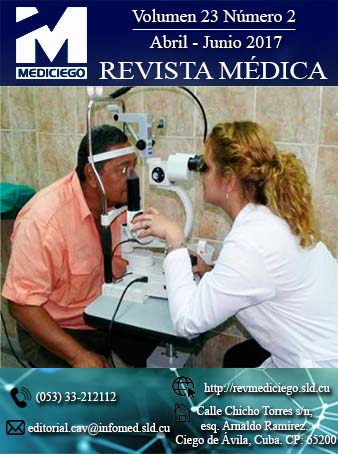Ketonuria in the diagnosis of acute appendicitis
Abstract
Introduction: the high prevalence of acute appendicitis, the lack of reliable predictors of this disease and the fact that in the bodies ward of hospital is not routinely measured the presence of ketone bodies in the urine of patients, it is necessary to verify the little evidence available about ketosis as a predictor of acute appendicitis.
Objective: to determine the possible reliability of ketonuria in the diagnosis of acute appendicitis.
Method: a quantitative, prospective, observational and descriptive study with analytical phases was performed at the General Surgery Service of the "Celia Sánchez Manduley" Provincial Surgical Clinic Hospital in Manzanillo, Granma, from December 2014 to April 2015.The universe consisted of 362 patients diagnosed with acute appendicitis. Each patient's urine was analyzed by means of test strips and the Imbert reaction to identify ketone bodies. A tabulation of the possible ketosis causes was carried out, which were quantified with the difference test of proportions. The results were presented in tables and graphs.
Results: taking into account all the patients diagnosed with acute appendicitis, 21 % presented ketosis. No statistically significant differences were found between the detection of ketosis by test strips and the reaction of Imbert: both tests showed specificity of 90% and low sensitivity (21 %) and effectiveness (37 %); in most cases it was possible to attribute the presence of ketone bodies to known causesDownloads
Published
How to Cite
Issue
Section
License
Copyright (c) 2021 Eva Alejandrina Lluiz Hernández, Pedro Rafael Casado Méndez, Rafael Salvador Santos Fonseca, Onelia Méndez Jiménez, Irene Luisa del Castillo Remón, Dolores Labrada González

This work is licensed under a Creative Commons Attribution-NonCommercial 4.0 International License.
Those authors who have publications with this journal accept the following terms of the License CC Attribution-NonCommercial 4.0 International (CC BY-NC 4.0):
You are free to:
- Share — copy and redistribute the material in any medium or format for any purpose, even commercially.
- Adapt — remix, transform, and build upon the material for any purpose, even commercially.
The licensor cannot revoke these freedoms as long as you follow the license terms.
Under the following terms:
- Attribution — You must give appropriate credit , provide a link to the license, and indicate if changes were made . You may do so in any reasonable manner, but not in any way that suggests the licensor endorses you or your use
- No additional restrictions — You may not apply legal terms or technological measures that legally restrict others from doing anything the license permits.
The journal is not responsible for the opinions and concepts expressed in the works, which are the exclusive responsibility of the authors. The Editor, with the assistance of the Editorial Committee, reserves the right to suggest or request advisable or necessary modifications. Original scientific works are accepted for publication, as are the results of research of interest that have not been published or sent to another journal for the same purpose.
The mention of trademarks of specific equipment, instruments or materials is for identification purposes, and there is no promotional commitment in relation to them, neither by the authors nor by the editor.






















